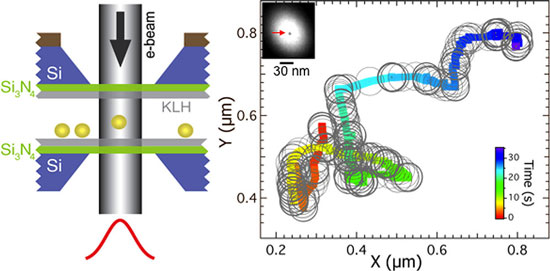| Posted: Oct 16, 2012 | |
E-beam 'tweezers' allow precise manipulation of single nanoparticles (w/video) |
|
| (Nanowerk Spotlight) The idea of using laser light to trap or levitate small particles goes back to the pioneering work by Arthur Ashkin of Bell Laboratories in the 1970s and 1980s. Ashkin found that radiation pressure – the ability of light to exert pressure to move small objects – could be harnessed to constrain small particles (see the original 1970 paper: "Acceleration and Trapping of Particles by Radiation Pressure"). | |
| This discovery has since formed the basis for scientific advances such as the development of optical tweezers – which are frequently used to control the motion of small biological objects. These techniques provide an extremely versatile toolbox for manipulating small particles and the systems being studied by optical trapping extend from large particles to biological molecules and even single atoms. | |
| However, optical trapping of nanoparticles remains a challenging task because the forces are often too small when the sizes of the objects are reduced to the nanometer scale. | |
| New findings from scientists at Lawrence Berkeley National Laboratory and National University of Singapore fill a gap and also open the door to new discoveries by demonstrating trapping and manipulating nanometer size particles using an electron beam instead of optical forces. It could also lead to new force spectroscopy where nanostructures can be assembled one nanoparticle at a time. | |
| In their work, reported in the October 4, 2012 online edition of Nano Letters ("Electron Beam Manipulation of Nanoparticles"), the team trapped gold nanoparticles inside an electron beam and showed that they can direct their movements over a membrane surface inside an environmental cell. | |
 |
|
| Left: Schematic of experimental set up, where an electron beam passes through the silicon nitride window and traps gold nanoparticles inside the beam. Right: Trajectories of the electron beam movement and the global movement of the gold nanoparticle. (Reprinted with permission from American Chemical Society) | |
| "Since an electron beam, such as the beam source of a transmission electron microscope (TEM) or a scanning electron microscope (SEM), can be focused into subnanometer sizes and easily operated to scan a surface up to millimeters, the ability to manipulate nanoparticles using an electron beam opens the opportunity to create a versatile tool for nanotechnology," Dr. Haimei Zheng, a staff scientist in the Materials Sciences Division at Lawrence Berkeley National Laboratory, explains to Nanowerk. | |
| "Using the electron beam, we can also trap multiple nanoparticles and assemble nanoparticles on the surface," says Zheng. "Manipulation of the nanoparticles using the electron beam can be easily combined with the conventional electron microscopy techniques, so that both manipulation and directly imaging the nanoparticles of interest can be achieved." | |
| A key tool leading to the team's findings arises from the microfabricated environmental cell used for this study: it contains two liquid reservoirs for liquid sample loading and an electron transparent silicon nitride window allowing the liquid sample to be examined under a TEM. Nanoparticles can be placed in the cell and subsequently moved in fluids with the beam without encountering the issues that other electron microscopy samples have, such as nanoparticles stuck on a TEM grid and exposed to vacuum. | |
| The team controlled the movements of the electron beam at approximately 10 nm per second – faster or slower movement of the beam is possible – and the single or multiple gold nanoparticles trapped inside the beam are dragged along with the beam while moving chaotically inside the beam. | |
| This video shows multiple gold nanoparticles trapped inside an electron beam; their ensemble displacement follows the movement of the beam. (Source: Lawrence Berkeley National Laboratory) | |
| Utkur Mirsaidov, a research fellow at the MechanoBiology Institute at National University of Singapore, who co-first authored the paper with Zheng, notes that the interaction between nanoparticles can be complex and diverse and although there is an attractive force between gold nanoparticles inside the electron beam, nanoparticles are bouncing vigorously and are not aggregated during an extended period of time. | |
| Using electron beam tweezers instead of optical tweezers makes it possible to precisely manipulate nanoparticles and to fabricate devices using nanoparticles as building blocks. It also is a great tool to probe the interaction forces between nanoparticles. This could potentially revolutionize nanoscale device fabrication – nanoparticles can be collected and fused together, allowing the creation of new materials architectures. | |
| Going forward, the team would like to position nanoparticles precisely and rapidly in a programmed fashion. This involves overcoming the random motion of nanoparticles and working with a confined space between membranes. | |
 By
Michael
Berger
– Michael is author of three books by the Royal Society of Chemistry:
Nano-Society: Pushing the Boundaries of Technology,
Nanotechnology: The Future is Tiny, and
Nanoengineering: The Skills and Tools Making Technology Invisible
Copyright ©
Nanowerk LLC
By
Michael
Berger
– Michael is author of three books by the Royal Society of Chemistry:
Nano-Society: Pushing the Boundaries of Technology,
Nanotechnology: The Future is Tiny, and
Nanoengineering: The Skills and Tools Making Technology Invisible
Copyright ©
Nanowerk LLC
|
|
|
Become a Spotlight guest author! Join our large and growing group of guest contributors. Have you just published a scientific paper or have other exciting developments to share with the nanotechnology community? Here is how to publish on nanowerk.com. |
|
